單元一:認識自閉特色
自閉特色世界瞭望塔
走進自閉特色的世界,讓我們登上瞭望塔,細看他們總總特色。本單元將深入淺出地讓學員認識常見的自閉特色 ,例如「拉闊的感官」、「獨特的系統化能力」、「專家的記憶」等。同時,我們會介紹在香港識別及評估自閉特色人士的一般流程和常見的專業支援服務。我們也會邀請不同的持份者,例如:精神科醫生、治療師、學校人員、僱主、自閉特色學童家長和自閉症倡導者等,分享他們的專業知識和親身經驗。
引入
第1部分 開展旅程
1.1 「自閉症」的起跑線
1.2 單元一學習大綱
1.3 參考資料
- Happé, F., & Frith, U. (2020). Annual Research Review: Looking back to look forward – changes in the concept of autism and implications for future research. Journal of Child Psychology and Psychiatry, 61(3), 218–232.
第一章自閉特色,齊來認識
第1部分 自閉特色腦袋
1.1 我的期望
1.你期望在本單元學到什麼?有什麼學習目標?

1.2 前測
1.3 自閉症譜系障礙是什麼?
1.4 不同的腦袋,不同的世界?
1.5 小測驗
1.以下哪項陳述是正確的 ?
- 我們能從腦部掃描判斷出自閉特色腦袋
- 自閉特色腦袋在部分結構和運作上,與一般腦袋有不相同的地方
- 擁有自閉特色腦袋的人士,表現完全相同
1.6 參考資料
- American Psychiatric Association. (2013). Diagnostic and statistical manual of mental disorders (5th ed.).
- Centers for Disease Control and Prevention. (2020, March 25). What is Autism Spectrum Disorder? https://www.cdc.gov/ncbddd/autism/facts.html
- Constantino, J. N., & Charman, T. (2016). Diagnosis of autism spectrum disorder: Reconciling the syndrome, its diverse origins, and variation in expression. The Lancet Neurology, 15(3), 279–291.
- Flaherty, D. K. (2011). The vaccine-autism connection: A public health crisis caused by unethical medical practices and fraudulent science. Annals of Pharmacotherapy, 45(10), 1302–1304.
- Kaiser, M. D., Hudac, C. M., Shultz, S., Lee, S. M., Cheung, C., Berken, A. M., Deen, B., Pitskel, N. B., Sugrue, D. R., Voos, A. C., Saulnier, C. A., Ventola, P., Wolf, J. M., Klin, A., Vander Wyk, B. C., & Pelphrey, K. A. (2010). Neural signatures of autism. Proceedings of the National Academy of Sciences, 107(49), 21223-21228.
- Kang, E., Keifer, C. M., Levy, E. J., Foss-Feig, J. H., McPartland, J. C., & Lerner, M. D. (2018). Atypicality of the N170 event-related potential in autism spectrum disorder: A meta-analysis. Biological Psychiatry: Cognitive Neuroscience and Neuroimaging, 3(8), 657–666.
- Maenner, M. J., Shaw, K. A., Baio, J., Washington, A., Patrick, M., DiRienzo, M., Christensen, D. L., Wiggins, L. D., Pettygrove, S., Andrews, J. G., Lopez, M., Hudson, A., Baroud, T., Schwenk, Y., White, T., Rosenberg, C. R., Lee, L. C., Harrington, R. A., Huston, M., … Dietz, P. M. (2020). Prevalence of autism spectrum disorder among children aged 8 Years-Autism and developmental disabilities monitoring network, 11 Sites, United States, 2016. MMWR Surveillance Summaries, 69(4), 1-12.
- van Rooij, D., Anagnostou, E., Arango, C., Auzias, G., Behrmann, M., Busatto, G. F., Calderoni, S., Daly, E., Deruelle, C., Di Martino, A., Dinstein, I., Duran, F., Durston, S., Ecker, C., Fair, D., Fedor, J., Fitzgerald, J., Freitag, C. M., Gallagher, L., Gori, I., … Buitelaar, J. K. (2018). Cortical and subcortical brain morphometry differences between patients with Autism Spectrum Disorder and healthy individuals across the lifespan: Results from the ENIGMA ASD Working Group. The American Journal of Psychiatry, 175(4), 359–369.
- Taylor, B., Miller, E., Farrington, C. P., Petropoulos, M. C., Favot-Mayaud, I., Li, J., & Waight, P. A. (1999). Autism and measles, mumps, and rubella vaccine: No epidemiological evidence for a causal association. Lancet, 353(9169), 2026–2029.
- Uddin, L. Q., Supekar, K., & Menon, V. (2013). Reconceptualizing functional brain connectivity in autism from a developmental perspective. Frontiers in human neuroscience, 7, 458.
- Vasa, R. A., Mostofsky, S. H., & Ewen, J. B. (2016). The disrupted connectivity hypothesis of Autism Spectrum Disorders: Time for the next phase in research. Biological psychiatry. Cognitive Neuroscience and Neuroimaging, 1(3), 245–252.
- Yang, D. Y. J., Beam, D., Pelphrey, K. A., Abdullahi, S., & Jou, R. J. (2016). Cortical morphological markers in children with autism: A structural magnetic resonance imaging study of thickness, area, volume, and gyrification. Molecular Autism, 7(1), 11.
第2部分 拉闊的感官
2.1 感官上的天賦
2.2 感官經驗齊體驗
2.3 小測驗
1.自閉特色人士在感覺訊息處理上的不同,可能基於_______。
- 大腦機能退化
- 大腦學習得來的
- 大腦在調節、組織以及篩選感覺訊息上有差異
(正確答案:C.大腦在調節、組織以及篩選感覺訊息上有差異)
2.自閉特色人士在感覺訊息處理上的不同,或會帶來_______。
- 特殊的技能
- 日常生活及情緒行為等方面的困擾
- 以上皆會
(正確答案:C.以上皆會)
2.4 參考資料
- American Psychiatric Association. (2013). Diagnostic and statistical manual of mental disorders (5th ed.).
- Ben-Sasson, A., Hen, L., Fluss, R., Cermak, S. A., Engel-Yeger, B., & Gal, E. (2009). A meta-analysis of sensory modulation symptoms in individuals with autism spectrum disorders. Journal of autism and developmental disorders, 39(1), 1–11.
- Bonnel, A., Mottron, L., Peretz, I., Trudel, M., Gallun, E., & Bonnel, A.-M. (2003). Enhanced pitch sensitivity in individuals with Autism: A signal detection analysis. Journal of Cognitive Neuroscience, 15(2), 226-235.
- Grandin, T. (2009). Visual abilities and sensory differences in a person with Autism. Biological Psychiatry, 65(1), 15-16.
- Heaton, P., Davis, R. E., & Happé, F. G. E. (2008). Research note: Exceptional absolute pitch perception for spoken words in an able adult with autism. Neuropsychologia, 46(7), 2095-2098.
- Leekam, S. R., Nieto, C., Libby, S. J., Wing, L., & Gould, J. (2007). Describing the sensory abnormalities of children and adults with autism. J Autism Dev Disord, 37(5), 894-910.
- Marco, E. J., Hinkley, L. B. N., Hill, S. S., & Nagarajan, S. S. (2011). Sensory processing in Autism: A review of neurophysiologic findings. Pediatric Research, 69(5), 48r-54r.
- Mottron, L., Burack, J. A., Stauder, J. E. A., & Robaey, P. (1999). Perceptual processing among high‐functioning persons with Autism. Journal of Child Psychology and Psychiatry, 40(2), 203-211.
- Silver, W. G., & Rapin, I. (2012). Neurobiological basis of Autism. Pediatric Clinics of North America, 59(1), 45-61
- Tavassoli, T., Miller, L. J., Schoen, S. A., Brout, J. J., Sullivan, J., & Baron-Cohen, S. (2018). Sensory reactivity, empathizing and systemizing in autism spectrum conditions and sensory processing disorder. Developmental Cognitive Neuroscience, 29, 72-77.
- Tsatsanis, K. D., & Powell, K. (2014). Neuropsychological Characteristics of Autism Spectrum Disorders. In R. P. F.R. Volkmar, S.J. Rogers and K.A. Pelphrey (Eds.), Handbook of Autism and Pervasive Developmental Disorders, Fourth Edition.
- 鮑冠吟, 林思瑜, & 林玲伊. (2014). 自閉症類群障礙症兒童的感覺處理問題:文獻回顧. Journal of Taiwan Occupational Therapy Research and Practice, 10(2), 103-114.
第3部分 局部的審視風格
3.1 你看到什麼?
一齊來投票,看看其他學員是否和你選擇的一樣
1.觀看下圖,你第一眼看見的字母是什麼?
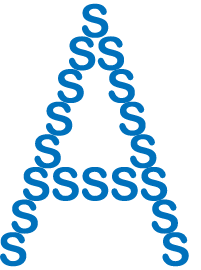
3.2 看得見的細節
3.3 想一想
1.你有沒有遇過自閉特色人士告知你沒為意的事物細節?你對他們這個「特質」有什麼感受?你欣賞他們這個「特質」嗎?

3.4 小測驗
1.有自閉特色的人士只懂留意事物的細節,沒有整體審視事物的能力。
- 是
- 否
(正確答案:B.否)
2.有自閉特色的人士有較大機會觀察到一般人未能為意的細節。以下是星仔爸爸的見解,你認為哪一項是對的?(可選多於一項)
- 他們的眼睛比較大
- 可能與他們較大的知覺負載容量有關
- 可能與他們獨特的注意力系統有關
(正確答案:B.可能與他們較大的知覺負載容量有關; C.可能與他們獨特的注意力系統有關)
3.5 參考資料
- Happé, F., & Frith, U. (2006). The weak coherence account: detail-focused cognitive style in autism spectrum disorders. Journal of autism and developmental disorders, 36(1), 5–25.
- Keehn, B., Müller, R. A., & Townsend, J. (2013). Atypical attentional networks and the emergence of autism. Neuroscience & Biobehavioral Reviews, 37(2), 164-183.
- Koldewyn, K., Jiang, Y. V., Weigelt, S., & Kanwisher, N. (2013). Global/local processing in autism: Not a disability, but a disinclination. Journal of autism and developmental disorders, 43(10), 2329-2340.
- Microsoft Corporate Blogs. (2015, April 3). Microsoft announces pilot program to hire people with autism. Retrieved December 18, 2020, from https://blogs.microsoft.com/on-the-issues/2015/04/03/microsoft-announces-pilot-program-to-hire-people-with-autism/
- Mottron, L., Dawson, M., Soulières, I., Hubert, B., & Burack, J. (2006). Enhanced perceptual functioning in autism: an update, and eight principles of autistic perception. Journal of autism and developmental disorders, 36(1), 27–43.
- Plaisted, K., Saksida, L., Alcántara, J., & Weisblatt, E. (2003). Towards an understanding of the mechanisms of weak central coherence effects: Experiments in visual configural learning and auditory perception. Philosophical Transactions of the Royal Society of London. Series B: Biological Sciences, 358(1430), 375-386.
- Plaisted, K., Swettenham, J., & Rees, L. (1999). Children with autism show local precedence in a divided attention task and global precedence in a selective attention task. Journal of child psychology and psychiatry, and allied disciplines, 40(5), 733–742.
- Posner, M. I., & Petersen, S. E. (1990). The attention system of the human brain. Annual review of neuroscience, 13(1), 25-42.
- Remington, A. (2015, April 15). Comment: Why employing autistic people makes good business sense. Retrieved December 18, 2020, from https://www.sbs.com.au/news/comment-why-employing-autistic-people-makes-good-business-sense
- Remington, A. M., Swettenham, J. G., & Lavie, N. (2012). Lightening the load: perceptual load impairs visual detection in typical adults but not in autism. Journal of abnormal psychology, 121(2), 544–551.
- Samson, F., Mottron, L., Soulières, I., & Zeffiro, T. A. (2012). Enhanced visual functioning in autism: an ALE meta-analysis. Human brain mapping, 33(7), 1553–1581.
- Swettenham, J., Remington, A., Murphy, P., Feuerstein, M., Grim, K., & Lavie, N. (2014). Seeing the unseen: Autism involves reduced susceptibility to inattentional blindness. Neuropsychology, 28(4), 563–570.
- Van der Hallen, R., Evers, K., Brewaeys, K., Van den Noortgate, W., & Wagemans, J. (2015). Global processing takes time: A meta-analysis on local-global visual processing in ASD. Psychological bulletin, 141(3), 549–573
第4部分 圖像思考的傾向
4.1 圖片搜尋器
4.2 想一想
1.你有否嘗試運用視覺支援策略?如有,請列出你曾採用的教具 / 策略(例如:安坐提示圖卡、深呼吸示範影片等)。

4.3 小測驗
1.根據影片提及的研究,自閉特色腦袋偏向運用哪個系統來理解句子?
- 偏向運用語言理解系統
- 偏向運用視覺影像系統
- 沒有區別地運用以上兩個系統
(正確答案:B.偏向運用視覺影像系統)
4.4 參考資料
- Dawson, M., Soulières, I., Gernsbacher, M. A., & Mottron, L. (2007). The level and nature of autistic intelligence. Psychological science, 18(8), 657–662.
- Kana, R. K., Keller, T. A., Cherkassky, V. L., Minshew, N. J., & Just, M. A. (2006). Sentence comprehension in autism: thinking in pictures with decreased functional connectivity. Brain : a journal of neurology, 129(Pt 9), 2484–2493.
- Grandin, T. (1996). Thinking in pictures: And other reports from my life with autism. Vintage Books.
- Grandin, T. (2009). How does visual thinking work in the mind of a person with autism? A personal account. Philosophical Transactions of the Royal Society B: Biological Sciences, 364(1522), 1437-1442.
- Goldstein, G., Beers, S. R., Siegel, D. J., & Minshew, N. J. (2001). A comparison of WAIS-R profiles in adults with high-functioning autism or differing subtypes of learning disability. Applied neuropsychology, 8(3), 148–154.
- Wong, C., Odom, S. L., Hume, K. A., Cox, A. W., Fettig, A., Kucharczyk, S., Brock, M. E., Plavnick, J. B., Fleury, V. P., & Schultz, T. R. (2015). Evidence-based practices for children, youth, and young adults with Autism Spectrum Disorder: A comprehensive review. Journal of Autism and Developmental Disorders, 45(7), 1951–1966.
- 香港 01 (2017). 來自星星的腦袋.片:自閉症人士親述 為何看不懂眉頭眼額?摘自 https://www.hk01.com/%E7%A4%BE%E5%8D%80%E5%B0%88%E9%A1%8C/105500
第5部分 獨特的「系統化」能力
5.1 腦筋急轉彎
1.試找出「?」的圖片

(正確答案:A![]() .)
.)
2.想一想,空格中的英文詞語是什麼?
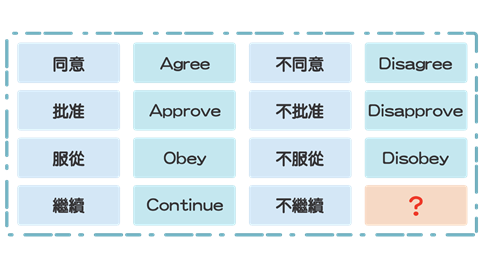
(正確答案 ︰Discontinue)
5.2 「系統化」的才能
5.3 小測驗
1.只有自閉特色人士才會把事物「系統化」?
- 是
- 否
(正確答案:B.否)
2.「系統化處理機制」與以下哪些具自閉特色的行為特徵有關?(可選多於一項)
- 重複行為
- 不能作全盤審視
- 對某些事物有濃厚的興趣
- 跟從規則做事
(正確答案:A.重複行為; C.對某些事物有濃厚的興趣; D.跟從規則做事)
5.4 參考資料
- Baron-Cohen S. (2006). The hyper-systemizing, assortative mating theory of autism. Progress in neuro-psychopharmacology & biological psychiatry, 30(5), 865–872.
- Baron-Cohen, S., Ashwin, E., Ashwin, C., Tavassoli, T., & Chakrabarti, B. (2009). Talent in autism: hyper-systemizing, hyper-attention to detail and sensory hypersensitivity. Philosophical transactions of the Royal Society of London. Series B, Biological sciences, 364(1522), 1377–1383.
- Baron-Cohen, S., & Lombardo, M. V. (2017). Autism and talent: the cognitive and neural basis of systemizing. Dialogues in clinical neuroscience, 19(4), 345–353.
- Lee, P. S., Foss-Feig, J., Henderson, J. G., Kenworthy, L. E., Gilotty, L., Gaillard, W. D., & Vaidya, C. J. (2007). Atypical neural substrates of Embedded Figures Task performance in children with Autism Spectrum Disorder. NeuroImage, 38(1), 184–193.
- Manjaly, Z. M., Bruning, N., Neufang, S., Stephan, K. E., Brieber, S., Marshall, J. C., Kamp-Becker, I., Remschmidt, H., Herpertz-Dahlmann, B., Konrad, K., & Fink, G. R. (2007). Neurophysiological correlates of relatively enhanced local visual search in autistic adolescents. NeuroImage, 35(1), 283–291.
- World Cube Association. (2020). Max Park: World Cube Association. Retrieved December 18, 2020, from https://www.worldcubeassociation.org/persons/2012PARK03
第6部分 專家的記憶
6.1 投票
一齊來投票,看看其他學員是否和你選擇的一樣
1.根據你認識的自閉特色人士,你認為他們的記憶力如何?(1是非常弱,10是非常強)
A.1
B.2
C.3
D.4
E.5
F.6
G.7
H.8
I.9
J.10
6.2 你有專家的記憶嗎?
6.3 小測驗
1.腦袋結構或訊息處理上的不同,或會影響自閉特色腦袋的哪個記憶歷程?
- 編碼(Encoding)
- 儲存 (Storage)
- 提取 (Retrieval)
- 以上皆有可能
(正確答案:D.以上皆有可能)
2.為什麼有自閉特色的人士和一般大眾也可能擁有「專家的記憶」?
- 他們有較強的語意記憶 (semantic)
- 他們可能對某些事物有特別深入的研究,所以格外記得當中的資料
- 因為記憶表現視乎涉及記憶哪一個歷程
(正確答案:B.他們可能對某些事物有特別深入的研究,所以格外記得當中的資料)
6.4 參考資料
- Baron-Cohen, S., & Lombardo, M. V. (2017). Autism and talent: the cognitive and neural basis of systemizing. Dialogues in clinical neuroscience, 19(4), 345–353.
- Ben Shalom D. (2003). Memory in autism: review and synthesis. Cortex; a journal devoted to the study of the nervous system and behavior, 39(4-5), 1129–1138.
- Boucher, J., Mayes, A., & Bigham, S. (2008). Memory, language and intellectual ability in low-functioning autism. In J. Boucher & D. Bowler (Eds.), Memory in Autism: Theory and Evidence (p. 268–290). Cambridge University Press.
- Boucher, J., Mayes, A., & Bigham, S. (2012). Memory in autistic spectrum disorder. Psychological Bulletin, 138(3), 458–496.
- Goddard, L. (2018). Development of autobiographical memory in autism spectrum disorders. In J. L. Johnson, G. S. Goodman, & P. C. Mundy (Eds.), The Wiley Handbook of Memory, Autism Spectrum Disorder, and the Law (p. 125–145). Wiley Blackwell.
- Jones, C. R., Happé, F., Pickles, A., Marsden, A. J., Tregay, J., Baird, G., Simonoff, E., & Charman, T. (2011). ‘Everyday memory’ impairments in autism spectrum disorders. Journal of Autism and Developmental Disorders, 41(4), 455–464.
- Lind, S., & Bowler, D. (2008). Episodic memory and autonoetic consciousness in autistic spectrum disorders: The roles of self-awareness, representational abilities and temporal cognition. In J. Boucher & D. Bowler (Eds.), Memory in Autism: Theory and Evidence (p. 166–187). Cambridge University Press.
- Losh, M., & Capps, L. (2003). Narrative ability in high-functioning children with autism or Asperger’s syndrome. Journal of Autism and Developmental Disorders, 33(3), 239–251.
- Millward, C., Powell, S., Messer, D., & Jordan, R. (2000). Recall for self and other in autism: children’s memory for events experienced by themselves and their peers. Journal of Autism and Developmental Disorders, 30(1), 15–28.
- Rogers, T. B., Kuiper, N. A., & Kirker, W. S. (1977). Self-reference and the encoding of personal information. Journal of personality and social psychology, 35(9), 677–688.
- Schultz, R. T., Gauthier, I., Klin, A., Fulbright, R. K., Anderson, A. W., Volkmar, F., Skudlarski, P., Lacadie, C., Cohen, D. J., & Gore, J. C. (2000). Abnormal ventral temporal cortical activity during face discrimination among individuals with autism and Asperger syndrome. Archives of General Psychiatry, 57(4), 331–340.
- Toichi, M. (2008). Episodic memory, semantic memory and self-awareness in high-functioning autism. In J. Boucher & D. Bowler (Eds.), Memory in Autism: Theory and Evidence (p. 143–165). Cambridge University Press.
- Tulving, E. (1985). How many memory systems are there? American Psychologist, 40(4), 385–398.
- Webb, S. J. (2008). Impairments in social memory in autism? Evidence from behaviour and neuroimaging. In J. Boucher & D. Bowler (Eds.), Memory in Autism: Theory and Evidence (p. 188–209). Cambridge University Press.
- Webb, S. J., Dawson, G., Bernier, R., & Panagiotides, H. (2006). ERP evidence of atypical face processing in young children with autism. Journal of Autism and Developmental Disorders, 36(7), 881–890.
- Wojcik, D. Z., Moulin, C. J., & Souchay, C. (2013). Metamemory in children with autism: exploring “feeling-of-knowing” in episodic and semantic memory. Neuropsychology, 27(1), 19–27.
第7部分 不一樣的的社交解讀
7.1 你知道我在想什麼嗎?
一齊來投票,看看其他學員是否和你選擇的一樣
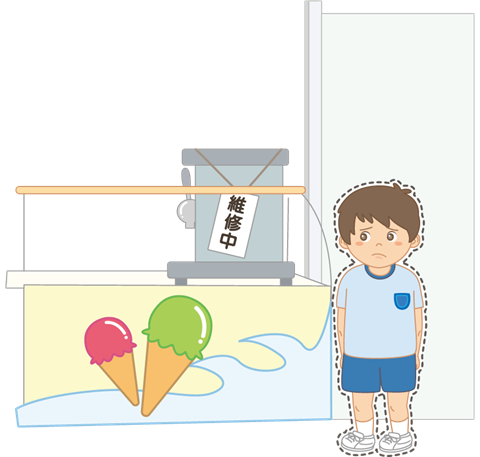
1.你認為這位學童有什麼想法?
A.他被罰站,所以不開心
B.家人遲遲未出現,他感到擔心
C.他想吃雪糕,但機器壞了,所以感到失望
2.你從什麼途徑推敲出學童的想法? (可選多於一項)
A.眼神
B.表情
C.動作
D.副語言
E.環境
F.以上皆不是
7.2 我的解讀和你的解讀
7.3 小測驗
1.以下哪一個陳述是正確的 ?
- 自閉特色人士沒有「心智解讀」的能力
- 自閉特色人士不知道別人跟自己有不同的想法
- 自閉特色人士可能運用了腦袋不同部分,來推敲別人的想法或感受
(正確答案:C.自閉特色人士可能運用了腦袋不同部分,來推敲別人的想法或感受)
7.4 參考資料
- Baron-Cohen, S., Jolliffe, T., Mortimore, C., & Robertson, M. (1997). Another advanced test of theory of mind: evidence from very high functioning adults with autism or asperger syndrome. Journal of Child Psychology and Psychiatry, and Allied Disciplines, 38(7), 813–822.
- Baron-Cohen, S., Ring, H. A., Wheelwright, S., Bullmore, E. T., Brammer, M. J., Simmons, A., & Williams, S. C. (1999). Social intelligence in the normal and autistic brain: an fMRI study. The European Journal of Neuroscience, 11(6), 1891–1898.
- Baron-Cohen, S., & Wheelwright, S. (2004). The empathy quotient: an investigation of adults with Asperger syndrome or high functioning autism, and normal sex differences. Journal of Autism and Developmental Disorders, 34(2), 163-175.
- Callaghan, T., Rochat, P., Lillard, A., Claux, M. L., Odden, H., Itakura, S., Tapanya, S., & Singh, S. (2005). Synchrony in the onset of mental-state reasoning: evidence from five cultures. Psychological Science, 16(5), 378–384.
- Chakrabarti, B., & Baron-Cohen, S. (2006). Empathizing: neurocognitive developmental mechanisms and individual differences. Progress in Brain Research, 156, 403–417.
- Happé F. G. (1994). An advanced test of theory of mind: understanding of story characters’ thoughts and feelings by able autistic, mentally handicapped, and normal children and adults. Journal of Autism and Developmental Disorders, 24(2), 129–154.
- Leslie, A. M. (1987). Pretense and representation: The origins of “theory of mind.” Psychological Review, 94(4), 412–426.
- 來跑一場親子障礙賽sen.org.hk (2017). 自閉症年輕人自白:我最需要怎樣的援兵。摘自https://www.youtube.com/watch?v=6dAs2YcEeLM
第8部分 小結
8.1 小總結

在第一章,大家認識到……
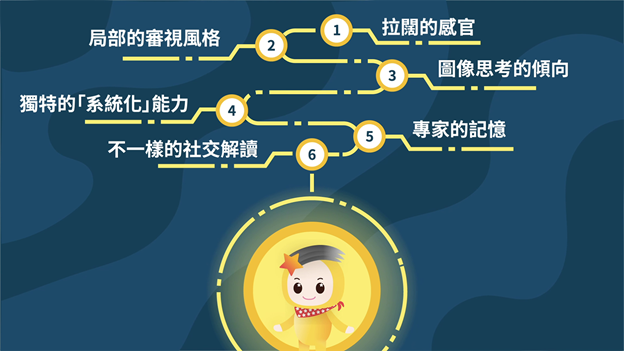
自閉特色人士可能會有很多不同的個人特色,但還有很多自閉特色未能與大家分享……
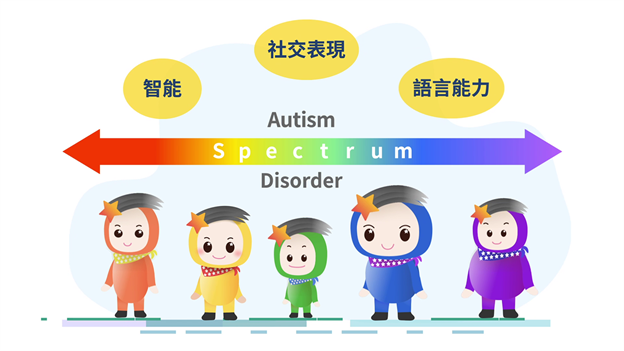
自閉症譜系障礙是一種譜系障礙,每位自閉特色人士的個別能力及所呈現的特色差異可以很大,再加上其他因素,例如智力、遺傳、家庭環境、歲數、性別、介入方式和時機等等的影響(Wozniak et al., 2017),沒有兩位有自閉特色的人士是完全相同的。
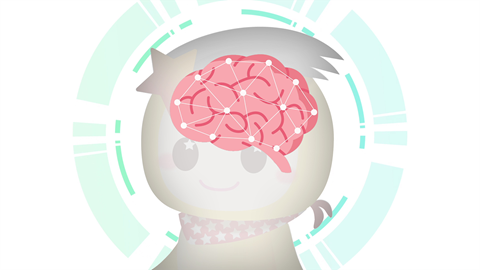
近二、三十年的腦神經科學研究,讓我們明白到自閉特色跟腦部的發展和運作息息相關

部分自閉特色腦袋會讓他們擁有獨特的特色和強項,與此同時,亦可能因理解日常訊息有別於大眾,因而令他們在社交、情緒和學習等方面,遇到不同程度的困難。

對擁有一般腦袋的普羅大眾而言,不免較難想像和理解有自閉特色人士所面對的困難。同樣地,有自閉特色腦袋的人士也可能需要付出很大的努力,才能明白大眾理解事物的角度

在接下來的章節,大家將會認識到如何及早識別有自閉特色人士,並會探討及早提供支援的重要性和方向
8.2 參考資料
- Wozniak, R. H., Leezenbaum, N. B., Northrup, J. B., West, K. L., & Iverson, J. M. (2017). The development of autism spectrum disorders: Variability and causal complexity. Wiley Interdisciplinary Reviews: Cognitive Science, 8(1–2), e1426.
第二章 識別及介入,不可不知道
第1部分 識別及診斷
1.1 總有一個在附近?
1.2 考考你

1.3 揭開診斷的秘密
1.4 知多一點點:如何為評估作準備?

家長可以如何為評估作準備?

家長可以預備學童的健康紀錄或病歷,若學童曾進行其他評估,也可帶備相關報告予醫生或心理學家作參考
醫生或心理學家會如何為孩子作評估?

醫生或心理學家可能會單獨會見學童,進行有關評估。在評估過程中,學童可能需要回答一些問題,做一些小任務等等。醫生或心理學家亦會從中觀察學童的行為,以及與自己的互動
家長可以如何跟孩子講述關於評估的事?

家長可事先了解評估流程及方式,然後向孩子作預告。家長可以簡單地告訴孩子將會去那裡以及進行怎樣的評估,會見到甚麼人,過程是怎樣,以減少孩子的不安。告訴孩子,醫生或心理學家會和他們聊天及會要他完成一些任務,主要是想了解他多一點
老師可以如何為評估作準備?

若學童是在上課期間會見教育心理學家,老師可向學童簡介會見的目的及流程,例如:他們將會在什麼時候及地點見面,他們的目的是想認識一下學童等等,讓他們作好心理準備。若學童會到兒童體能智力測驗中心或公立醫院接受評估,老師可協助家長作評估前的準備,與家長更新學童在校內的情況,及提供學童的課堂表現紀錄(例如:成績表、老師評語等)
1.5 小測驗
1.如果你懷疑學童有自閉症譜系障礙,可以怎樣做?
- 先待一會,可能隔一段時間就會變好
- 自己根據診斷條件下判斷
- 帶學童到相關的機構或尋求專業人士幫助
(正確答案:C.帶學童到相關的機構或尋求專業人士幫助)
1.6 參考資料
- American Psychiatric Association. (2013). Diagnostic and statistical manual of mental disorders (5th ed.).
- Bauminger N. (2002). The facilitation of social-emotional understanding and social interaction in high-functioning children with autism: intervention outcomes. Journal of Autism and Developmental Disorders, 32(4), 283–298.
- Bhandari, S. (2019, October 15). ADHD or Autism? How Are ADHD and Autism Different?. https://www.webmd.com/add-adhd/childhood-adhd/adhd-or-autism
- Centers for Disease Control and Prevention. (2019, December 9). Important Milestones: Your Baby By Eighteen Months. https://www.cdc.gov/ncbddd/actearly/milestones/milestones-18mo.html
- Centers for Disease Control and Prevention. (2019, December 9). Important Milestones: Your Baby By Three Years. https://www.cdc.gov/ncbddd/actearly/milestones/milestones-3yr.html
- Census and Statistics Department. (2014, December). Social data Collected via the General Household Survey : Special Topics Report – Report No.62- Persons with disabilities and chronic diseases. https://www.censtatd.gov.hk/hkstat/sub/sp380.jsp?productCode=C0000055
- Child Assessment Service. (2018, April). Autism Spectrum Disorder. https://www.dhcas.gov.hk/file/conditions/ASD_TC__18072018.pdf
- Gadow, K. D., DeVincent, C. J., & Pomeroy, J. (2006). ADHD symptom subtypes in children with pervasive developmental disorder. Journal of autism and developmental disorders, 36(2), 271–283.
- Goldstein, S., & Schwebach, A. J. (2004). The comorbidity of Pervasive Developmental Disorder and Attention Deficit Hyperactivity Disorder: results of a retrospective chart review. Journal of Autism and Developmental Disorders, 34(3), 329–339.
- Lee, D. O., & Ousley, O. Y. (2006). Attention-deficit hyperactivity disorder symptoms in a clinic sample of children and adolescents with pervasive developmental disorders. Journal of Child and Adolescent Psychopharmacology, 16(6), 737–746.
- Leyfer, O. T., Folstein, S. E., Bacalman, S., Davis, N. O., Dinh, E., Morgan, J., Tager-Flusberg, H., & Lainhart, J. E. (2006). Comorbid psychiatric disorders in children with autism: interview development and rates of disorders. Journal of Autism and Developmental Disorders, 36(7), 849–861.
- Loomes, R., Hull, L., & Mandy, W. (2017). What Is the Male-to-Female Ratio in Autism Spectrum Disorder? A Systematic Review and Meta-Analysis. Journal of the American Academy of Child and Adolescent Psychiatry, 56(6), 466–474.
- Maenner, M. J., Shaw, K. A., Baio, J., Washington, A., Patrick, M., DiRienzo, M., Christensen, D. L., Wiggins, L. D., Pettygrove, S., Andrews, J. G., Lopez, M., Hudson, A., Baroud, T., Schwenk, Y., White, T., Rosenberg, C. R., Lee, L. C., Harrington, R. A., Huston, M., … Dietz, P. M. (2020). Prevalence of autism spectrum disorder among children aged 8 Years-Autism and developmental disabilities monitoring network, 11 Sites, United States, 2016. MMWR Surveillance Summaries, 69(4), 1-12.
- Romero, M., Aguilar, J. M., Del-Rey-Mejías, Á., Mayoral, F., Rapado, M., Peciña, M., … & Lara, J. P. (2016). Psychiatric comorbidities in autism spectrum disorder: A comparative study between DSM-IV-TR and DSM-5 diagnosis. International Journal of Clinical and Health Psychology, 16(3), 266-275.
第2部分 及早介入
2.1 及早介入的重要性
2.2 職場上的支援與優勢
2.3 選擇適合的訓練
2.4 很多「T」
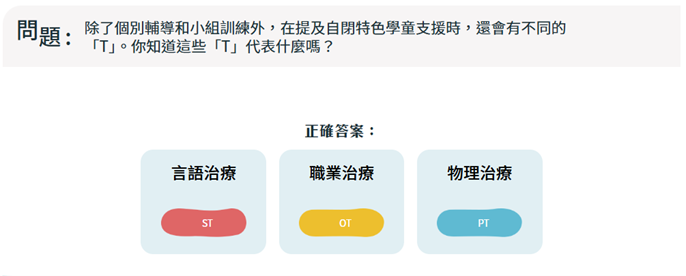
2.5 齊來認識不同的「T」
2.6 持份者協作
2.7 小測驗
1.若要學童把不同訓練習得的知識與技能,有效地應用於日常生活中,各持份者的溝通和協作是十分重要的。當中的持份者包括哪些人?(可選多項)
A.自閉特色學童本人
B.自閉特色學童的朋友
C.自閉特色學童的父母
D.支援自閉特色學童的專業人士
E.自閉特色學童的學校人員
(正確答案:A.自閉特色學童本人; B.自閉特色學童的朋友; C.自閉特色學童的父母; D.支援自閉特色學童的專業人士; E.自閉特色學童的學校人員)
2.及早介入十分重要,如果錯過了「黃金時期」,訓練就沒有效用。
A.是
B.否
(正確答案:B.否)
2.8 參考資料
- Blakemore, S. J., & Mills, K. L. (2014). Is adolescence a sensitive period for sociocultural processing?. Annual review of psychology, 65, 187-207.
- Doidge, N. (2007). The brain that changes itself: Stories of personal triumph from the frontiers of brain science.
- Estes, A., Zwaigenbaum, L., Gu, H., St John, T., Paterson, S., Elison, J. T., Hazlett, H., Botteron, K., Dager, S. R., Schultz, R. T., Kostopoulos, P., Evans, A., Dawson, G., Eliason, J., Alvarez, S., Piven, J., & IBIS network (2015). Behavioral, cognitive, and adaptive development in infants with autism spectrum disorder in the first 2 years of life. Journal of neurodevelopmental disorders, 7(1), 24.
- Wong, C., Odom, S. L., Hume, K. A., Cox, A. W., Fettig, A., Kucharczyk, S., Brock, M. E., Plavnick, J. B., Fleury, V. P., & Schultz, T. R. (2015). Evidence-Based Practices for Children, Youth, and Young Adults with Autism Spectrum Disorder: A Comprehensive Review. Journal of autism and developmental disorders, 45(7), 1951–1966.
- Mills, K. L., Goddings, A. L., Clasen, L. S., Giedd, J. N., & Blakemore, S. J. (2014). The developmental mismatch in structural brain maturation during adolescence. Developmental neuroscience, 36(3-4), 147–160.
- Fox, S. E., Levitt, P., & Nelson, C. A., 3rd (2010). How the timing and quality of early experiences influence the development of brain architecture. Child development, 81(1), 28–40.
- Luxford, S., Hadwin, J. A., & Kovshoff, H. (2017). Evaluating the effectiveness of a school-based cognitive behavioural therapy intervention for anxiety in adolescents diagnosed with autism spectrum disorder. Journal of Autism and Developmental Disorders, 47(12), 3896–3908.
- Voos, A. C., Pelphrey, K. A., Tirrell, J., Bolling, D. Z., Wyk, B. vander, Kaiser, M. D., McPartland, J. C., Volkmar, F. R., & Ventola, P. (2013). Neural mechanisms of improvements in social motivation after pivotal response treatment: Two case studies. Journal of Autism and Developmental Disorders, 43(1), 1–10.
- 東華三院(2018)。《「賽馬會喜伴同行計劃」自閉特色學生小組訓練資源套(小學版)第六冊 友好行為》。香港:香港賽馬會。
- 香港大學心理學系(2018)。《「賽馬會喜伴同行計劃」自閉特色學生小組訓練資源套(小學版)使用指南》。
第3部分 小結
3.1 小結
3.2 參考資料
- Maenner, M. J., Shaw, K. A., Baio, J., Washington, A., Patrick, M., DiRienzo, M., Christensen, D. L., Wiggins, L. D., Pettygrove, S., Andrews, J. G., Lopez, M., Hudson, A., Baroud, T., Schwenk, Y., White, T., Rosenberg, C. R., Lee, L. C., Harrington, R. A., Huston, M., … Dietz, P. M. (2020). Prevalence of autism spectrum disorder among children aged 8 Years-Autism and developmental disabilities monitoring network, 11 Sites, United States, 2016. MMWR Surveillance Summaries, 69(4), 1-12.
第三章總結
第1部分 旅程紀錄
1.1 在本單元我學會了……
1.2 鳴謝
本課程單元得以下各方鼎力相助,謹此致謝!
(按筆劃序排列)
受訪者
- 布樹燊先生(香港耀能協會)
- 陳永昌副校長(港大同學會書院)
- 陳國齡醫生(瑪麗醫院精神科部門及兒童及青少年精神科)
- 陳蔚濠先生(香港明愛成長學前到校支援服務)
- 鄧百亨先生
- 譚錦儀女士(太古資源有限公司)
- 蘇國豪先生(協康會)
- Eunice 女士
其他人士 / 機構
- 明愛青年生涯導航工程
- 明愛樂務綜合職業訓練中心
- 香港社會服務聯會
- 香港耀能協會
- 香港01有限公司
- 李嘉澍先生
- 莊詠芝女士
- 羅雨嫣女士
- Chris 先生
1.3 參考資料
- Butcher, S. (2020, July 15). JPMorgan found autistic people have special coding powers. eFinancialCareers. https://news.efinancialcareers.com/uk-en/3003960/jpmorgan-found-autistic-people-have-special-coding-powers.
第2部分 所學所得
2.1 我的期望
1.你認為有達到以下期望嗎?(6= 完全達到,1=完全未能達到)

2.2 後測
2.3 課後自評
1.就各項的同意程度:
(非常不同意/ 不同意/ 傾向 不同意/ 傾向 同意/ 同意/ 非常 同意)
A.本單元能提升我對自閉特色的了解
B.本單元有助我明白及早識別的重要性和診斷自閉症譜系障礙的情況
C.本單元有助我明白實證為本和跨專業合作介入的重要性
D.單元內容切合我需要
E.單元內容深淺程度合適
F.總括來說,本單元使我得益
G.總括來說,我對是次學習歷程感到滿意
2.完成本單元後,你將可以修讀有關提升學童情緒和社交方面的單元。若本平台增加其他單元,你會期望學習以下哪些課題(可選多項):
- 溝通及對話技巧
- 自我管理(包括:專注、組織、時間管理)
- 處理分歧及協商
- 朋輩相處、友好行為
- 應對欺凌
- 升中適應、思考及學習技巧
- 生活技能
- 自我倡導
- 中文寫作
3.「賽馬會喜伴同行計劃—— 走進自閉特色的世界」 網上學習平台界面設計能促進學習
(非常不同意/ 不同意/ 傾向 不同意/ 傾向 同意/ 同意/ 非常 同意)
4.以下的教學形式能助我有效學習:
(非常不同意/ 不同意/ 傾向 不同意/ 傾向 同意/ 同意/ 非常 同意)
A.教學影片
B.體驗練習
C.互動遊戲
D.小測驗
5.相較其他自閉症譜系障礙的網上資源,我較喜歡「賽馬會喜伴同行計劃——走進自閉特色的世界」 網上學習平台,因為以下因素:(可選多項)
- 課程內容專業
- 日常實踐建議
- 反思/體驗練習
- 資源/教材下載
- 網站設計
- 不用付費
- 其他
- 不適用



